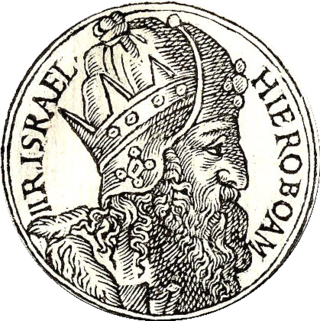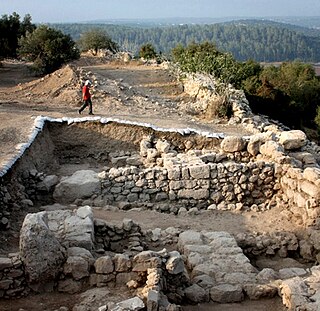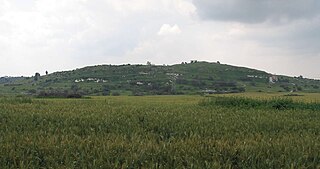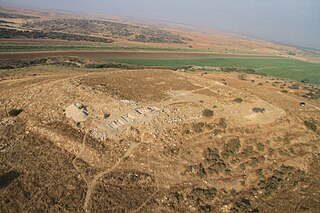
Aren Maeir (born 1958) is an American-born Israeli archaeologist and professor in the Department of Land of Israel Studies and Archaeology at Bar-Ilan University. [1] He is director of the Tell es-Safi/Gath Archaeological Project. [2]

Aren Maeir (born 1958) is an American-born Israeli archaeologist and professor in the Department of Land of Israel Studies and Archaeology at Bar-Ilan University. [1] He is director of the Tell es-Safi/Gath Archaeological Project. [2]
Aren Maeir was born in Rochester, New York, United States. He immigrated to Israel in 1969 and has lived there since. Following his service in the Israel Defense Forces (where he reached the rank of captain), he did his undergraduate and graduate studies at the Hebrew University in Jerusalem (PhD 1997 summa cum laude), and did a post-doctorate (2002-2003) at the (now defunct) Dibner Institute for the History of Science and Technology at MIT. He has been teaching at Bar-Ilan University since 1992. [3]
He has participated in, and directed, numerous archaeological excavations in Israel, including at the following sites: Jerusalem, Hazor, Yoqneam, Tell Qasile, Beth-Shean, and since 1996, at Tell es-Safi/Gath. He is married to Adina (née Hartman), and they have three sons and four grandchildren.
His expertise lies in the Bronze and Iron Age cultures of the Eastern Mediterranean, with special emphasis on those of the Ancient Levant. Among the topics that he has studied are: ancient trade; metallurgy; pottery production and provenance; scientific applications in archaeology; archaeological survey; the archaeology of Jerusalem; the Middle Bronze Age of the Levant; chronology of the 2nd Millennium BCE; the Sea Peoples and the Philistines; relations between Egypt and the Levant; ancient weapons and warfare; ancient cult and religion.
Between 2005 and 2007 he served as the Chairman of the Martin (Szusz) Department of Land of Israel Studies and Archaeology () at Bar-Ilan University. Along with Prof. Steve Weiner of the Weizmann Institute of Science in Rehovot, he initiated and co-directed the now defunct joint Bar-Ilan University/Weizmann Institute of Science program in Archaeological Science. He currently (2020-) is the director of the Institute of Archaeology at Bar-Ilan University, co-director of the Minerva Center for the Relations between Israel and Aram in Biblical Times (RIAB; aramisrael.org), director of the Ingeborg Rennert Center for Jerusalem Studies, and co-editor of the Israel Exploration Journal.
Since 1996 he has directed the Ackerman Family Bar-Ilan University Expedition to Gath, excavating the ancient site of Tell es-Safi, which is identified as Canaanite and Philistine Gath (one of the five cities of the Philistines mentioned in the Bible, the home of Goliath). Over the years, he has written and edited, close to 20 volumes and published around 300 papers.

Jeroboam II was the son and successor of Jehoash and the thirteenth king of the ancient Kingdom of Israel, over which he ruled for forty-one years in the eighth century BC. His reign was contemporary with those of Amaziah and Uzziah, kings of Judah.

The Philistines were an ancient people who lived on the south coast of Canaan during the Iron Age in a confederation of city-states generally referred to as Philistia.

Beit She'an, also Beth-shean, formerly Beisan, is a town in the Northern District of Israel. The town lies at the Beit She'an Valley about 120 m below sea level.

Ekron, in the Hellenistic period known as Accaron was a Philistine city, one of the five cities of the Philistine Pentapolis, located in present-day Israel.

Amihai "Ami" Mazar is an Israeli archaeologist. Born in Haifa, Israel, he has been since 1994 a professor at the Institute of Archaeology of the Hebrew University of Jerusalem, holding the Eleazer Sukenik Chair in the Archaeology of Israel.

Israel Finkelstein is an Israeli archaeologist, professor emeritus at Tel Aviv University and the head of the School of Archaeology and Maritime Cultures at the University of Haifa. Finkelstein is active in the archaeology of the Levant and is an applicant of archaeological data in reconstructing biblical history. Finkelstein is the current excavator of Megiddo, a key site for the study of the Bronze and Iron Ages in the Levant.

Gezer, or Tel Gezer, in Arabic: تل الجزر – Tell Jezar or Tell el-Jezari is an archaeological site in the foothills of the Judaean Mountains at the border of the Shfela region roughly midway between Jerusalem and Tel Aviv. It is now an Israeli national park. In the Hebrew Bible, Gezer is associated with Joshua and Solomon.

Hazael was an Aramean king who is mentioned in the Bible. Under his reign, Aram-Damascus became an empire that ruled over large parts of Syria and Israel. While he was likely born in the greater Damascus region of today, his exact place of birth is still controversial, with both Bashan and the Beqaa Valley being favoured by different historians.

According to the Deuteronomistic history in the Hebrew Bible, a United Monarchy or United Kingdom of Israel existed under the reigns of Saul, Eshbaal, David, and Solomon, encompassing the territories of both the later kingdoms of Judah and Israel.

Gath or Gat was one of the five cities of the Philistine pentapolis during the Iron Age. It was located in northeastern Philistia, close to the border with Judah. Gath is often mentioned in the Hebrew Bible and its existence is confirmed by Egyptian inscriptions. Already of significance during the Bronze Age, the city is believed to be mentioned in the El-Amarna letters as Gimti/Gintu, ruled by the two Shuwardata and 'Abdi-Ashtarti. Another Gath, known as Ginti-kirmil also appears in the Amarna letters.

Tel Zayit is an archaeological tell in the Shephelah, or lowlands, of Israel, about 30 km east of Ashkelon.

KhirbetQeiyafa, also known as Elah Fortress and in Hebrew as Horbat Qayafa, is the site of an ancient fortress city overlooking the Elah Valley and dated to the first half of the 10th century BCE. The ruins of the fortress were uncovered in 2007, near the Israeli city of Beit Shemesh, 30 km (20 mi) from Jerusalem. It covers nearly 2.3 ha and is encircled by a 700-meter-long (2,300 ft) city wall constructed of field stones, some weighing up to eight tons. Excavations at site continued in subsequent years. A number of archaeologists, mainly the two excavators, Yosef Garfinkel and Saar Ganor, have claimed that it might be one of two biblical cities, either Sha'arayim, whose name they interpret as "Two Gates", because of the two gates discovered on the site, or Neta'im; and that the large structure at the center is an administrative building dating to the reign of King David, where he might have lodged at some point. This is based on their conclusions that the site dates to the early Iron IIA, ca. 1025–975 BCE, a range which includes the biblical date for the biblical Kingdom of David. Others suggest it might represent either a North Israelite, Philistine, or Canaanite fortress, a claim rejected by the archaeological team that excavated the site. The team's conclusion that Khirbet Qeiyafa was a fortress of King David has been criticised by some scholars. Garfinkel (2017) changed the chronology of Khirbet Qeiyafa to ca. 1000–975 BCE.
Rafi Greenberg (Rafael) is a senior lecturer in archaeology at Tel Aviv University.

Tell es-Safi was an Arab Palestinian village, located on the southern banks of Wadi 'Ajjur, 35 kilometers (22 mi) northwest of Hebron which had its Arab population expelled during the 1948 Arab–Israeli war on orders of Shimon Avidan, commander of the Givati Brigade.
Jeffrey R. Chadwick is an American professional archaeologist and university professor. He serves as Jerusalem Center Professor of Archaeology and Near Eastern Studies at the Brigham Young University Jerusalem Center in Israel, and as Associate Professor of Religious Education at Brigham Young University in Utah, USA. He is also a senior field archaeologist and director of excavations in Area F at the Tell es-Safi/Gath Archaeological Project in Israel.

Tel Burna is an archaeological site located in the Shephelah, along the banks of Nahal Guvrin, not far from modern-day Qiryat Gat. Tel Burna is located near Beit Guvrin/Maresha, Tel Goded, Lachish, Tell es-Safi/Gath and Tel Zayit. The site is thought to have been one of a series of sites along the border between Judah and Philistia.
Seymour Gitin is an American archaeologist specializing in ancient Israel, known for his excavations at Tel Miqne-Ekron. He was the director of the Albright Institute of Archaeological Research (AIAR) in Jerusalem from 1980 to 2014.

Tel Erani or Tell esh-Sheikh Ahmed el-ʿAreini is a multi-period archaeological site on the outskirts of Kiryat Gat in the Southern District of Israel. It is also known by the name ʻIrâq el-Menshiyeh, although thought to have borne the original Arabic name of Menshiyet es-Saḥalīn. The tell was first occupied in the Chalcolithic period, but its most notable remains are from the Bronze Age and Iron Age, when it was the site of a substantial Philistine city with links to Egypt. It has been identified with the biblical cities of Libnah, Gath, Mmst, Eglon and Makkedah, but none of these identifications are certain. The city was destroyed in the 6th century BCE, possibly by the Babylonians. In the Persian period, it was the site of a temple. There are also signs of settlement in the Hellenistic, Byzantine, and Mamluk periods. The Palestinian village of Iraq al-Manshiyya was located at the foot of the tell until it was depopulated in the 1948 Arab–Israeli War.

Oded Lipschits is an Israeli professor in the Department of Archaeology and Ancient Near East Studies at Tel Aviv University. In 1997 he earned his Ph.D. in Jewish History under the supervision of Nadav Na'aman. He has since become a Senior Lecturer and Full Professor at Tel Aviv University and served as the Director of the Tel Aviv Institute of Archaeology since 2011. Lipschits is an incumbent of the Austria Chair of the Archeology of the Land of Israel in the Biblical Period and is the Head and founder of the Ancient Israel Studies Masters program in the Department of Archaeology and Ancient Near East Studies.

The Tell es-Safi inscription was found in 2005 at the archaeological site at Tell es-Safi, identified with the biblical city of Gath. It was under the destruction layer at the beginning of Iron Age IIA.